Breastfeeding Positions
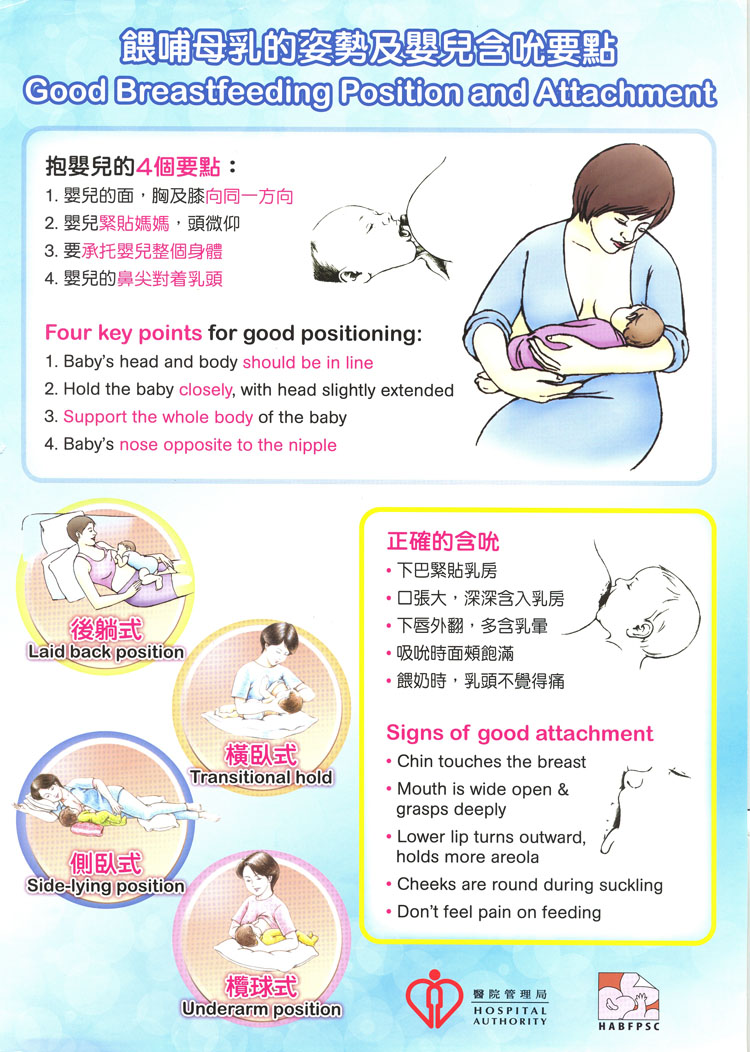
Laid back position
- The mother is to lean back and be well supported on a bed or couch. When putting the baby on the mother's chest, gravity will keep him / her in position and the body molded to the mother's.
- Have the motherˇ¦s head, back and elbows well supported with cushions / pillows. Let the babyˇ¦s cheek rest somewhere near the mother's bare breast. The whole front of the babyˇ¦s body should touch the mother's whole front.
- The baby can rest in a position that the mother likes, just making sure that his / her whole front is against the mother's.
- The advantages of this method are that the baby can instinctively take the initiative to find the breast and suckle, while the mother can assist and encourage the baby in a relaxed manner.
- This method is particularly suitable when the mother is a bit tired. But if the mother is exhausted or under the influence of medication after childbirth, taking into account the safety of the baby in case if the mother falls asleep, it is preferable to have a family member to stay at the bedside to take care of and observe her.
- If the flow of the motherˇ¦s milk is too fast, this method can also slow down the rate through gravity.
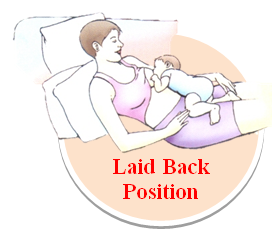
Transitional hold
- The mother should sit straight, with her back resting on a chair. Her body should slightly lean forward without bending too much of the back and neck. A foot pedal or beveled stool can be placed under her feet for support.
- The mother is to cradle or hold the baby across her lap, with the baby lying on his / her side. He / she should be resting on his / her shoulder and hip, with the mouth levels with the nipple of the mother.
- Pillows / cushions are to be used to lift the baby and support the motherˇ¦s elbows to bring the baby up to the nipple height especially during the first few weeks.
- The mother can support her breast using either a "U" or "C" hold, using the hand on the same side of her breast.
- The baby's head will be on the motherˇ¦s opposite forearm and his / her back will be along motherˇ¦s inner arm and palm.
- When the mother looks down, she should see her baby's side.
- She can put the baby's head on the breast when he / she widely opens the mouth instead of placing the nipple into it. In good attachment, the babyˇ¦s lower lip should turn outward and cover the areola below. The chin is indenting the breast. More areola will be seen above the top lip than the bottom lip if the areola is seen.
- Be sure that the baby's ear, shoulder and hips should be in a straight line. As a newborn, the baby's head and bottom should be at the same level.
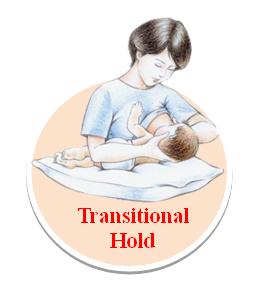
Side-lying position
- Lying down is a comfortable position for many nursing mothers, especially at night.
- When using this method, both the mother and baby are to lie on their sides facing each other.
- The mother's head is to be supported. To help her getting comfortable, she can use pillows behind her back and bottom or between her knees.
- During the positioning, the mother can use her hand to keep the baby's back in position. In helping the baby in getting milk more easily, the mother can keep the baby's hips flexed and his ear, shoulder and hip in one line.
- The breast can be supported with a "C" hold, using her hand on the opposite side of the breast.
- Same as in transitional hold, instead of placing the nipple into the babyˇ¦s mouth, the mother can put the baby's head on the breast when he / she widely opens it. In good attachment, the babyˇ¦s lower lip should turn outward and cover the areola below. The chin is indenting the breast. More areola will be seen above the top lip than the bottom lip if the areola is visible.
- After the baby is well positioned and attached to the breast, the mother should remove her supporting hand from the babyˇ¦s back and rest it beside her own head.
- To prevent the baby from rolling away from the mother, a pillow or rolled blanket can be placed behind the baby's back to support his / her position.
- If this method is used when the mother is very tired or under the influence of medication, it is advisable to have the companion of a family member to stay at the bedside to take care of and observe her. This will avoid jeopardising the safety of the baby if the mother falls asleep during feeding.
- This position is also useful during daytime.
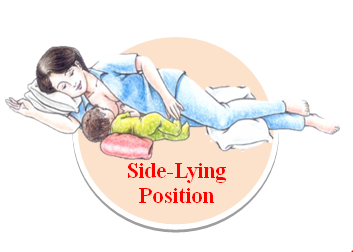
Underarm position
- Keeping the baby away from the incision, this is a good position for a mother who has had a Caesarean birth
- Most newborns feel comfortable in this position. It also helps when a mother has a forceful milk ejection reflex (let down) because the baby can handle the flow more easily.
- When adopting this position, the motherˇ¦s body should slightly lean forward without too much bending of her back and neck. A foot pedal or beveled stool can be placed under her feet for support.
- To facilitate a good control on the babyˇ¦s position, the mother is to support the baby's head in her hand and the babyˇ¦s back along her arm beside her. The baby's legs and feet are tucked under the motherˇ¦s arm, with his hips flexed and his legs resting alongside the motherˇ¦s back rest. The babyˇ¦s chest should now be facing the motherˇ¦s breast, with his mouth at nipple height.
- The breast can be supported with a "C" hold, using her hand on the opposite side of the breast.
- The mother can put the baby's head on the breast when he / she widely opens the mouth. Do not try to place the nipple into the baby's mouth. In good attachment, the baby's lower lip should turn outward and cover the areola below. The chin is indenting the breast. More areola will be seen above the top lip than the bottom lip if the areola is visible.
- If needed, pillows could be used to bring up the baby to the correct height and to reduce the pressure on the motherˇ¦s arm and wrist. However, to avoid the mother leaning forward excessively, the pillow support should not be placed at too low a level.
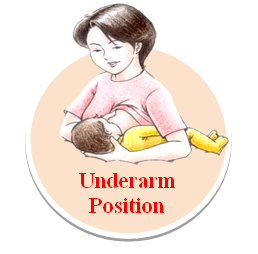
Source of above diagrams: Hospital Authority Breastfeeding Promotion Subcommittee